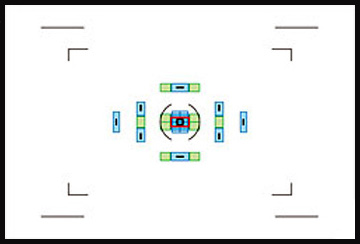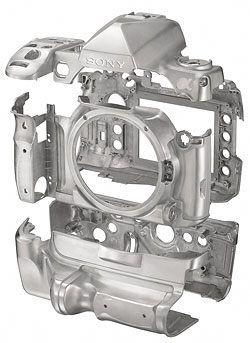Sony A900 Full-Frame: Hands-On Preview
by Wesley Fink on September 12, 2008 12:00 AM EST- Posted in
- Digital Camera
A900 Praise
When a camera and company truly break new ground, as the A900 does, there is plenty to like. The A900 also exhibits quite a few market firsts:

The blue bars are the 9 AF sensors and the green bars are the 10 hidden AF assist points.
The outer lines are used to compose 16:9 HD format, and the etched corners are APS-C mode.
The outer lines are used to compose 16:9 HD format, and the etched corners are APS-C mode.
- The Most Amazing Viewfinder - If the reason for an SLR is the through-the-lens view, and it certainly is in the opinion of most, then the A900 wins in spades with the brightest, sharpest viewfinder seen in any SLR in a long time - perhaps ever. Sony and the Minolta engineering staff they bought have lavished attention on the prism and 100% view and it clearly shows. The only complaint is that eye-relief, while excellent, could be even better. It will be difficult for some eyeglass wearers to see the whole viewfinder and displays without moving their eye a bit. The view is so beautiful and clear you will definitely want to see it all.
- A 24.6MP CMOS Sensor - Some will complain that noise is not as low as the Nikon D3 at high ISOs, and the answer is so what? The A900 is the highest resolution full-frame you can buy and twice the resolution of the D3. If you think that doesn't matter ask a working professional who is trying to supply images to his ad agency. Image buyers are demanding larger and larger files from photographers and the Sony delivers.
- Body-Integrated Image Stabilization - Calling it SteadyShot Inside instead of Super SteadyShot is just a marketing decision. The technology is still "Super SteadyShot" and Sony had to beef up the drive motors by 50% just to keep up with the added motion of a full-frame. Industry observers marveled when Minolta made the APS-C sensor Image Stabilized, because it was so much harder than stabilizing the tiny P&S sensors. We should all stand in awe that Sony accomplished body IS in a full-frame sensor.
- Image Stabilization with Any Lens - With body IS any lens you can mount can be an IS lens. This is particularly welcomed in very large aperture lenses, which are often prohibitively expensive for optical IS since such huge elements have to be compensated. Sony has taken advantage of this with a growing collection of fast, but very expensive, Zeiss lenses.

- Rugged Magnesium Alloy Body with Complete Weather Sealing - Sony passed around the alloy shell of the A900 at the A900 introduction. It is amazing how light the structure actually is considering the incredible strength of the assembled shell. We also saw full seals and gaskets for all buttons and openings and the rubber gaskets for ports seal effectively but are still easy to remove and reseal.
- Very Decent High ISO Noise - Compared to its real competition, which is the Canon 1Ds Mark III, the Sony sensor is amazingly low noise. According to pro photographers we talked with who have been shooting the A900 for several weeks the A900 is cleaner at ISO 800 and 1600 than the Mark III and just as clean at ISO 400. If this proves to be true in test comparisons this should certainly be considered a Sony success. The Canon 5D replacement may write a new chapter in this comparison, but only if it destroys the 1Ds Mark III performance. The A900 is not a D3 or D700 as it only goes to ISO 6400 and shooting at 3200 and 6400 is a when needed option - not something you want to do routinely. However, the A900 is also twice the resolution of the D3 and D700.
- 126 MB per Second - the Dual BIONZ processors in the A900 move 126MB/sec at the 5 fps shooting speed - faster even than the Canon 1Ds III. That's pretty good performance for a camera that will sell for $3k instead of the $8K for the Canon.

- Flash that Makes L Brackets Obsolete - Fortunes have been made with L brackets for pro cameras that enable shooting flash vertical with the flash also rotated 90 degrees. When you see the new Sony HVL-F58AM flash, you'll wonder why Sony - or you, or anyone else - didn't think of it sooner. The flash head turns smoothly in a 90 degree arc as one of its movements - aligning the flash perfectly for portrait mode. Goodbye L bracket.
- Sony PhotoHD output to Bravia TV - The support for direct tethered output via HDMI to Sony's Photo HD on a Sony Bravia TV is no passing feature. The performance and results seen at the Toronto hands-on were stunning. Output from the A900 model shoot and the studio shoot with fishing lures and flies was direct to huge Sony HD Bravia displays.
- Complete Familiarity - Users of the Sony A700 will have no learning curve at all, which is always a good thing. The layout of the A700 and A900 and grips are exactly the same, making for instant familiarity.
- True RAW Files - The Sony A700 has been criticized by some sites for not providing true RAW images, as even the Sony RAW had some noise-reduction applied with questionable success. The A900 finally has the RAW option of "No Noise Reduction". Sony will also provide this option to A700 owners in the upcoming firmware version 4.










53 Comments
View All Comments
Wesley Fink - Friday, September 12, 2008 - link
That is the EN-EL4(a) battery for the Nikon Pro cameras and the Sony capacity is specified as 1650mAh and not 16500. We do need an edit function here!dr4gon - Friday, September 12, 2008 - link
The memory stick is so that you have the ability to shoot RAW+JPG. It's just for redundancy in case your compact flash card dies for whatever reason. All is not lost since the JPEGs can be saved on the MS like the a700.VirtualMirage - Friday, September 12, 2008 - link
On the a700 you can only shoot to one memory card or the other at any given time. When set to RAW+JPEG, it doesn't send one file to one card and the other file to the other card (that option is not even available). It would be neat if it did, though, since I could have used that feature with my a700 when doing a wedding shoot back in June. The camera also doesn't automatically switch over to the other card when the first card is full, you have to go into the menu and switch it over manually. The a900, from reading a preview on another site, does the exact same thing in regards to memory card management as the a700 (which is a bit of a shame).As for the use of a memory stick and CF, I can understand the con with this since if you want to have a fall back memory card you have to deal with two different memory card formats. But the advantage to it, though, is a smaller camera profile since two CF card slots would require a little more room.
Below are some features I wish my a700 did (as well as the new a900) in regards to its two memory card slots:
-Automatic switchover when the first card is full.
-Option to have RAW files go to one card and a JPEG version go to the other card.
-Backup mode where ever picture shot is copied (in the same file format) to both cards.
Shame they don't do this. But oh well, the a700 is still a great camera. And with the new firmware that got leaked out earlier this week (v.4), it's an even better camera since they added some features to the a700 that are in the a900. Some of these improvements are: High ISO NR can now be turned off (used to be you can go no further than LOW), Image quality algorithms have been improved with NR on and off (finer grain pattern in high ISO shots, no more watercolor NR), EV bracketing now has a +/- 2 option for HDR shooting, and some people are reporting WB has improved in certain lighting. Their maybe more improvements, but since it was leaked with no update readme (and was quickly removed from the site too when it was discovered), the only improvements mentioned are what people have found after installing it. Supposedly, the official release of the firmware update is sometime next week (the 16th is what I am hearing). Probably so as to not steal the a900's thunder.
~Paul